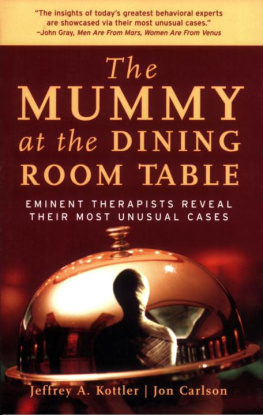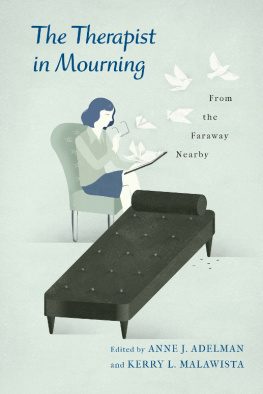


To our children: Cary, and Kirstin, Matt, Karin, Ben, and Kali, hoping they have learned the lessons we've tried to live, that is, to learn from mistakes after acknowledging them.
You will not recognize anyone you know in this book (great efforts have been made to disguise their identities), but you may certainly see aspects of yourself reflected in their incredible stories. The people profiled in these cases were faced with difficult and unusual challenges, not so different from those you may have confronted in your own life. What is different are the ways these individuals attempted to cope with their demons, the perseverance they displayed, and their good fortune to end up under the care of an extraordinary therapist.
Although the stories in this book are indeed quite amazing and unusual, this is not a book that glorifies the most bizarre aspects of human behavior. It is instead a collection of tales about psychotherapy relationships that were as transformative for the therapists as they were for their clients. These are stories of compassion and caring, tales that demonstrate the kind of commitment practitioners make to their craft. This is not a book that intentionally makes heroes and heroines of therapists (although there are plenty of quite amazing and creative strategies by some of the greatest practitioners alive). Rather it is a book that celebrates the courage of individuals who, in the face of overwhelming and debilitating problems, manage to overcome these challenges through hard work and continual trust in their professional helpers.
WHY THESE CASES?
In the field of human behavior, we have seen more than our fair share of unusual and challenging cases. Many of these have not only shaped the development of psychotherapy but also captured public interest. Sigmund Freud's case of Anna 0. was seminal in the evolution of psychoanalysis. Here was a young woman presenting symptoms of blurred vision, difficulty swallowing, and a paralyzed right arm, but with no physical causes for these problems. Freud and his colleague Josef Breuer found themselves not only challenged to treat the first case of hysteria but also enamored by the peculiarities of Anna's condition. (Breuer became a little too enamored with Anna, but that's another story.)
In more recent times, the story of Sybil, the first documented case of multiple personality disorder, was a runaway best-seller. Clinicians were not the only ones who were interested in reading about this woman with sixteen distinct personalities and how her therapist managed to deal with the challenge. The same is certainly true of other books that have followed in the tradition of presenting strange cases for popular consumption. The Man Who Mistook His Wife for a Hat spawned a whole industry of stories about people who have weird neurological, psychological, or behavioral disorders.
We wondered why strange behavior holds such fascination not only for the public at large but also for members of our profession. There are reasons why we remember particular cases, even after twenty or thirty years, but forget others. There is also some meaning in the choice we make to discuss one case out of the thousands we have seen in our lives. Why do we consider one patient more unusual or distinctive than all the others?
In some cases, the therapists picked the patient who represented the first of something-the first success or failure, the first representative of a diagnostic entity (a borderline or schizophrenic disorder, for example). More often, the cases selected were those that were high in "novelty," meaning that they were just so different from anything or anyone else the therapist had seen before or since. Nevertheless, which case each of us chose says as much about who we are as it does about the people we describe.
WHY THESE THERAPISTS?
Consider that therapists, as a group, are among the most articulate and verbally expressive people around. As a profession, we are well trained and highly experienced in all the nuances of communication, problem conceptualization, and interpersonal relationships. We are good talkers and experts at explaining complex ideas in understandable terms. What we do for a living, essentially, is persuade people to do things they don't want to do, and convince people to surrender sacred (but self-destructive) beliefs they have held all their lives.
Now consider further that among this population of professionals who are the most skilled talkers around, there is a subgroup-the top fraction of 1 percent-who are still even more articulate. These are people who have developed theories followed by all the rest. They are the ones who write the books and manuals that guide other clinicians. These are the therapists you see on talk shows, read about in articles, or hear interviewed on the radio. These are the best and brightest members of a profession that already represents some of the most intelligent, perceptive, sensitive, and interpersonally effective people. These are the people whose voices you will hear in this book.
Our collection of stories come from thirty of the most prominent and well-regarded therapists. They live in different parts of the world. They are trained in different disciplines of psychology, psychiatry, counseling, family therapy, and social work. They represent radically different approaches to therapy: psychoanalytic, cognitive-behavioral, constructivist, feminist, humanistic, systemic, and all the rest. It could probably be said that many of the therapists in this book don't so much follow a particular theoretical orientation as much as they have invented one. Between them, they have written most of the major books in the field that guide all other therapists.
In this book, you will have the opportunity to hear the greatest living theorists and practitioners talk about their strangest cases. In each story, you will not only gain an intimate look at how individuals have chosen to adapt in unique ways to adversity in their lives but also get an inside peek at how some of the greatest minds of our generation sort out the complexities of the situation in such a way as to cure their clients' presenting problems. As never before, you will learn about how therapists work with their most challenging clients, and you will gain a deeper understanding of human suffering.
















